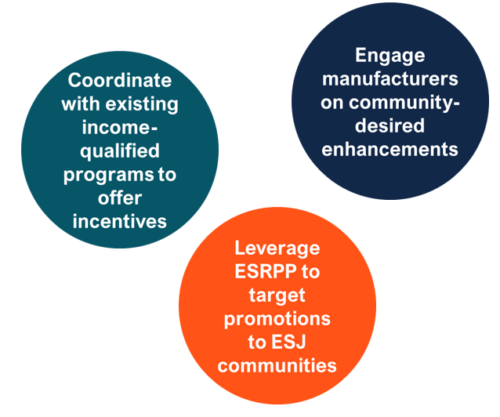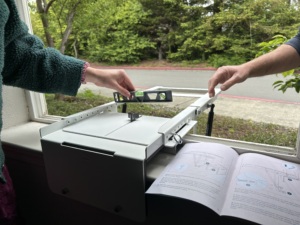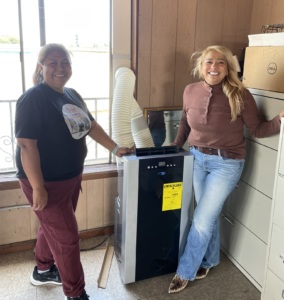
The 2024 ACEEE Summer Study on Energy Efficiency in Buildings brought together more than 1,200 energy professionals last month to share their innovative work and collaborate on solutions to persistent challenges, centered on the theme Equity and Climate Action: Time to Deliver. During the conference, CalMTA team members were able to share our work to integrate equity considerations into a market transformation approach in a paper included in the Summer Study proceedings. The paper, An equity lens for market transformation: Delivering ESJ benefits at scale through an integrated program design approach, was authored by Melinda Lopez of The Ortiz Group, Sepideh Rezania of Unrooz Solutions, and Rachel Good of Resource Innovations and was presented on a market transformation panel focused on infusing equity in transformational program design.
The California Public Utilities Commission (CPUC) Decision that led to the formation of a statewide market transformation administrator calls for CalMTA’s market transformation initiatives (MTIs) to include “strategies to maximize equity” and should consider transformational efforts that “maximize energy savings, health, affordability, and job access” for environmental and social justice (ESJ) communities. This is new ground for market transformation, which typically prioritizes demand-side opportunities and supply chain interventions that will most effectively drive market adoption. Applying an equity lens to our work requires unique and thoughtful attention on consumers with fewer resources and more complex barriers to adoption as well as consideration of opportunities to break down those barriers early in the lifecycle of a market transformation initiative.
Without these specific interventions to break down barriers, the communities facing the greatest energy burden will only gain access to energy efficiency years later, if at all. Failing to prioritize equity would leave out the roughly 30% of California residents that live in poverty or near-poverty.

In 2023, CalMTA created strategies to help integrate equity considerations into our program and MTI development process. The past year has allowed us to apply the elements of our “equity lens” to the ideas we are developing, resulting in an integrated program design approach that elevates equity considerations and can deliver benefits at scale to ESJ communities. The sections below describe CalMTA’s standard approach to embedding equity in our MTI development, accompanied by examples of how this worked in practice during development of our Room Heat Pump MTI (formerly Portable/Window Heat Pumps).

Prioritizing equity begins with our idea selection process when we determine what areas of the market we want to focus on and how best to allocate resources. We use an open Request for Ideas process that invites idea submittals from any interested party and does not require significant time or complex technical deliverables, with targeted outreach to encourage participation from ESJ organizations. Equity questions are also embedded in our scoring criteria and used to prioritize submitted ideas. As a result, one of the first ideas selected to move forward was submitted by a community organization doing energy justice work and a technology – room heat pumps – with high equity potential.

Once we decided to move forward with this MTI, we needed to better understand the potential target market and validate our initial market transformation theory and potential interventions in developing a conceptual logic model that seeks to reflect the needs and values of ESJ communities. To do so, CalMTA conducted market characterization interviews that included income-qualified program implementers, Tribal representatives, and nonprofit organizations, as well as focus groups held in English and Spanish with consumers across the state, which specifically targeted low- and moderate-income participants.
Findings informed the conceptual logic model, which included equity-focused strategic interventions such as:
- coordinating with current weatherization/affordable housing programs to promote inclusion of this technology,
- leveraging the ENERGY STAR® Retail Products Platform in select stores to target and provide special incentives for ESJ communities, and
- engaging manufacturers to explore product enhancements with significant interest to ESJ communities, like air filtration.


In addition to preliminary market characterization work, we directly engage with ESJ communities to better understand the barriers they face and priorities we could support, and to elevate their voices in MTI design.
Listening sessions held with ESJ community representatives benefited from established best practices like compensating participating organizations, facilitating sessions in a way that encouraged open dialogue and honest feedback, and ensuring diverse representation across session participants through thoughtful recruitment. Feedback received during these listening sessions directly inspired one of CalMTA’s Strategy Pilots. Participants conveyed that despite manufacturer claims, room heat pumps were heavy and cumbersome to install so CalMTA is now working to test the” do-it-yourself” nature of room heat pump installs.


Photos from the Room Heat Pump Self-Installation Practices Strategy Pilot

We leveraged existing, trusted communication channels in the community, by engaging local partners to recruit participants and ensure our approach provided value to those households. Testing potential approaches and interventions in tandem with local partners helped inform challenges and opportunities to the product. For instance, few currently available window heat pumps will fit the form of horizontal sliding windows, which represent a significant portion of affordable housing in Southern California. We also learned that many low-income buildings have bars on the window, which could prevent installations due to safety concerns. We are working with manufacturers to present these findings and seek solutions for developing new form factors.

Developing meaningful equity impact metrics for MTIs that we can track and report on is another critical part of CalMTA’s equity lens. CalMTA has thought creatively about how equity-focused performance indicators can be developed at both the organizational and individual MTI level to enable continuous improvement and provide accountability to the ESJ community representatives engaged in our work. In a second round of Listening Sessions, we were able to share and solicit feedback on some preliminary metrics to ensure they resonated with this audience. For instance, participants encouraged CalMTA to look beyond immediate actions like initial adoption toward metrics that evaluate the long-term impact of MTIs, such as improved community health, sustained energy savings, and enhanced economic opportunities.
While there are many perspectives and strategies used to integrate equity considerations in energy efficiency work, market transformation requires a unique approach. CalMTA’s forming experience applying an equity lens to MTI development provides one potential pathway that is replicable for other entities pursuing similar market-level program design. As we move forward with MTI development, we will continue deepening our understanding of how equity can be effectively addressed through market transformation – applying what we’ve learned and refining our approach as our work unfolds in the market.






